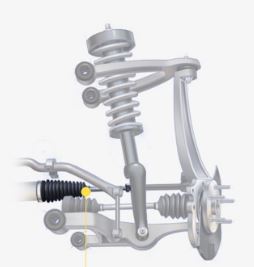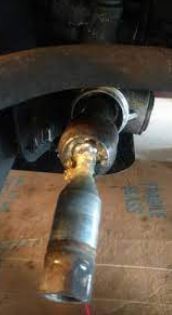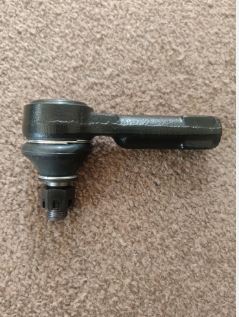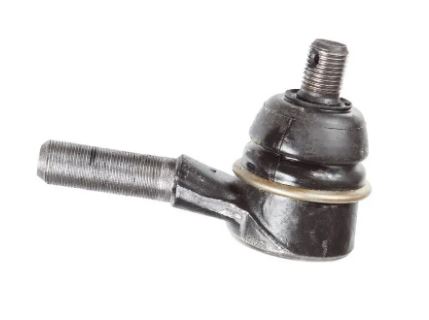The tie rod ends play a crucial role in the steering system of a vehicle, connecting the steering knuckles to the steering gear. Proper lubrication of these components is essential for ensuring smooth and safe steering. Grease is the most common lubricant used for tie rod ends, but many vehicle owners are unsure whether they need to grease new tie rod ends. we will explore the importance of greasing tie rod ends, whether or not new tie rod ends need to be greased, and the risks of not greasing them. So, do you need to grease new tie rod ends? Let’s find out.
Understanding Tie Rod Ends

Tie rod ends are an essential component of a vehicle’s steering system. They connect the steering gear or rack to the steering knuckle, allowing the vehicle to turn and maneuver. Understanding how to tie ends work and how to maintain them is important for ensuring safe and reliable vehicle operation.
Tie ends are ball and socket joints that allow for movement and flexibility in the steering system. They consist of an inner and outer tie rod end, connected by a threaded rod. The outer tie rod end connects to the steering knuckle, while the inner tie rod end connects to the steering gear or rack.
As the driver turns the steering wheel, the steering gear or rack moves the inner tie rod end, which in turn moves the outer tie rod end and the steering knuckle. This movement allows the wheels to turn and steer the vehicle.
Over time, tie ends can wear out or become damaged, causing issues with steering and handling. Signs of worn or damaged tie ends include steering wheel vibration, uneven tire wear, and a loose or wandering steering feel.
Regular maintenance of tie ends is important for ensuring safe and reliable vehicle operation. This includes checking for wear and damage during routine inspections, and replacing any worn or damaged tie rod ends as needed. It is also important to have the vehicle’s alignment checked and adjusted as necessary, as misaligned wheels can put additional strain on the tie rod ends and cause premature wear.
Why Grease Tie Rod Ends

Greasing tie rod ends is an important maintenance task that helps ensure the smooth and safe operation of your vehicle. Tieends are critical components of a car’s steering system, connecting the steering gear to the steering knuckle, which ultimately turns the wheels.
Over time, tie ends can become worn or damaged due to constant use, road conditions, and exposure to the elements. This can result in steering problems, such as vibrations, wandering, or a loss of control. Regularly greasing tie ends can help prevent these issues by reducing friction and wear, and extending their lifespan.
When tie ends are greased, a high-quality lubricant is applied to the joint where the tie rod connects to the steering knuckle. This lubricant helps reduce friction between the components, which reduces wear and tear. Additionally, it aids in preventing the accumulation of dust, debris, and other pollutants that can cause corrosion and damage.
To grease tie ends, the vehicle’s front wheels are lifted off the ground, and a grease gun is attached to the fitting on the tie rod end. The grease gun is used to inject grease into the joint until it starts to overflow. This ensures that the joint is properly lubricated and that excess grease is pushed out, which can help prevent damage.
It’s recommended to have tie ends greased at least once a year or every 10,000 miles, whichever comes first. However, if you notice any symptoms of steering problems, such as vibrations or wandering, it’s important to have your tie ends inspected and greased as soon as possible.
How to Grease Tie Rod Ends
Here are the steps to grease tie ends:
- Locate the tie rod ends: The tie ends are located at the ends of the steering rack, where they connect to the steering knuckles. You will need to crawl under the vehicle and look for them.
- Clean the tie rod ends: Before you grease the tie ends, you will need to clean them thoroughly. To clean out any dirt, grease, or debris from the tie ends’ surface, use a degreaser or brake cleaner.
- Prepare the grease gun: You will need a grease gun to inject grease into the tie ends. Fill the grease gun with the appropriate type of grease for your vehicle. If you’re not sure what kind of grease to use, see your owner’s manual or consult a mechanic.
- Attach the grease fitting: The tie ends have a grease fitting that you will need to attach the grease gun to. The fitting is usually located on the side of the tie rod end, near the steering knuckle. Remove the cap or cover from the fitting and attach the grease gun.
- Pump the grease: With the grease gun attached, pump the grease into the tie rod end. You should see the grease start to come out of the top of the tie rod end. Keep pumping until you see clean grease coming out of the top.
- Wipe away excess grease: After you have finished pumping grease into the tie rod end, wipe away any excess grease with a clean rag. Be sure to clean up any spilled grease from the surrounding area as well.
- Repeat for the other tie rod ends: Repeat the process for the other tie ends on your vehicle. Most vehicles have two tie ends, one on each side.
Do You Need to Grease New Tie Rod Ends

Tie ends are an essential component of the steering system in a vehicle. They connect the steering rack to the steering knuckle, which is attached to the wheel. Tie ends are responsible for transmitting the force from the steering system to the wheels, allowing the driver to control the direction of the vehicle.
New tie ends typically come pre-greased from the factory. However, it is recommended to check and ensure that they have enough grease and add more if needed before installation. This is because tie ends require proper lubrication to function correctly and extend their lifespan.
Grease helps reduce friction and wear between the moving parts of the tie rod end. Without proper lubrication, the tie rod end can wear out quickly, causing excessive play in the steering and potentially compromising the safety of the vehicle. Additionally, lack of lubrication can cause the tie rod end to make a noise, such as squeaking or creaking.
It is also essential to periodically inspect and maintain the tie ends to ensure they are still properly lubricated. Fresh grease should be used in place of any that has been soiled or contaminated. Regular maintenance can help extend the lifespan of the tie ends and ensure proper steering and handling of the vehicle.
Risks of Not Greasing New Tie Rod Ends
Tie ends are an essential component of the steering system in a vehicle, connecting the steering rack or center link to the steering knuckle. They allow for the movement of the wheels when turning the steering wheel, which makes them crucial for safe driving. When tie ends are replaced, it is important to grease them properly to ensure they function correctly. Failure to do so can result in several risks.
Firstly, not greasing new tie ends can cause premature wear and tear. The joints in the tie ends are constantly moving and can be subject to significant stress. Without proper lubrication, the joints can wear out more quickly, leading to excessive play in the steering system. This can cause the vehicle to feel loose and unstable, especially at high speeds, which can compromise safety.
Secondly, not greasing new tie ends can result in increased steering effort. When the joints of the tie ends are not properly lubricated, they can become stiff, making it difficult to turn the steering wheel. This may make it harder to control the car, which is particularly troublesome for drivers who do not have the muscle or endurance to turn the wheel easily.
Thirdly, not greasing new tie ends can result in steering system failure. In some cases, the tie ends may become so worn that they fail completely, causing the steering to become inoperable. This can be quite risky because it may result in the vehicle losing control, especially if it happens at high speeds or in heavy traffic.
Finally, not greasing new tie ends can result in increased maintenance costs. When tie ends are not lubricated properly, they can wear out more quickly, which means they will need to be replaced sooner. This can result in increased maintenance costs, as well as the inconvenience of having to bring the vehicle in for repairs more frequently.
How Often Should You Grease Tie Rod Ends
Tie ends are a crucial component of a vehicle’s steering system that connects the steering rack to the wheel. They are responsible for transmitting the driver’s input to the wheels and ensuring the wheels turn in the correct direction. Greasing tie ends is essential to keep them lubricated and prevent premature wear and tear, which can lead to steering problems and safety issues.
So, how often should you grease tie rod ends? It depends on various factors, such as the vehicle’s make and model, driving conditions, and the type of grease used. In general, it is recommended to inspect and grease tie ends every 12,000 miles or at least once a year, whichever comes first.
However, if you frequently drive on rough roads or off-road, you may need to grease tie ends more often, perhaps every 6,000 miles or every six months. The same goes for vehicles that are frequently used for towing or carrying heavy loads. On the other hand, if you drive mostly on smooth, paved roads, you may be able to go longer between greasing tie rod ends, perhaps up to 18,000 miles or two years.
It’s essential to use the correct type of grease when greasing tie ends. Always refer to the vehicle’s manual or consult with a mechanic to ensure you are using the appropriate grease for your vehicle. Over greasing or using the wrong type of grease can cause damage to the tie rod ends and other steering components.
Tips for Maintaining Tie Rod Ends

- Regular Inspections: It’s essential to inspect the tie ends regularly to ensure they are in good condition. Look for signs of wear or damage, such as cracks, dents, or loose fittings. If any damage is detected, the tie rod ends must be replaced immediately.
- Keep the Grease in Check: The tie rod ends must be adequately lubricated to function correctly. Use a grease gun to apply grease to the fittings on the tie ends regularly. Make sure you use the recommended grease and don’t over-grease the fittings, as this can cause damage.
- Avoid Potholes and Bumps: Tie rod ends can get damaged from hitting potholes or bumps on the road. Try to avoid driving over rough terrain as much as possible. When you do encounter rough roads, drive slowly and carefully to minimize any impact.
- Check for Proper Alignment: The tie rod ends must be aligned correctly to ensure they work correctly. If the alignment is off, it can cause uneven wear on the tie ends and lead to premature failure. Check the alignment regularly and have it adjusted by a professional if necessary.
- Replace Worn Components: If any components of the steering system are worn, it’s important to replace them immediately. Worn components can put additional strain on the tie rod ends, causing them to fail prematurely.
FAQs About Do You Need to Grease New Tie Rod Ends
Can I over-grease tie rod ends?
Yes, over-greasing tie ends can lead to damage and even failure of the components. Always follow the manufacturer’s recommendations for the amount of grease to use.
How can I tell if my tie rod ends need to be greased?
One sign that your tie rod ends may need to be greased is if you hear a clunking or popping noise when turning the steering wheel. You can also inspect the tie ends for any signs of wear or damage.
Can I use any type of grease for my tie rod ends?
No, it is important to use a grease that is specifically formulated for tie ends. Using the wrong type of grease can lead to premature wear and failure of the components.
Can I grease my tie rod ends without a grease gun?
While a grease gun is the most efficient tool for greasing tie rod ends, it is possible to grease them by hand using a small amount of grease and a clean rag. However, this method may not be as effective as using a grease gun.
Can I drive with worn-out tie rod ends?
No, driving with worn-out tie rod ends can be extremely dangerous as it can cause the steering to become loose or unresponsive, leading to loss of control of the vehicle. If you suspect that your tie ends are worn-out, have them inspected and replaced as soon as possible.
Final Thought
In the end, the question of do you need to grease new tie rod ends is important for ensuring the safety and longevity of your vehicle’s steering system. Proper lubrication is crucial for preventing wear and tear on the tie rod ends and other steering components, as well as avoiding potential safety hazards. While it may be tempting to assume that new tie rod ends come pre-greased, it is important to check the manufacturer’s recommendations and take the necessary steps to ensure that they are properly lubricated. Remember, regular maintenance and inspection of your vehicle’s steering system can go a long way in preventing costly repairs and ensuring your safety on the road. So, if you’re wondering whether you need to grease new tie ends, the answer is a resounding yes.
Related Topic:
- When to Use White Lithium Grease on Rubber Bushings
- How To Remove Grease From Hands And Nails
- Where to Put Dielectric Grease on Spark Plugs
- What Happens If You Don’t Grease Brake Pads
- Different Types of Grease
- Can You Use Dielectric Grease on Brake Caliper Pins
- White Lithium Grease vs WD-40
- Is Red and Tacky Grease Good for Wheel Bearings
- what happens if you don’t grease your ball joints


